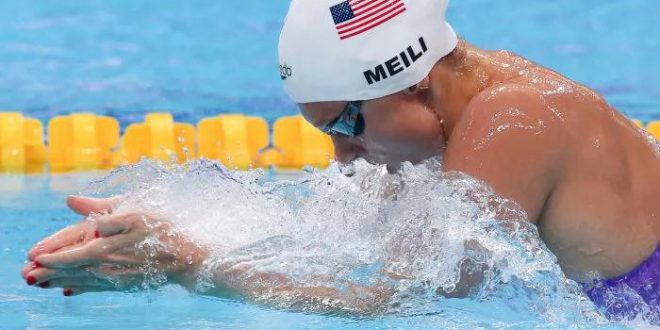曾经有一段时间我和我的俱乐部团队一起教授游泳。由于动作与其他三种泳姿的差异,蛙泳始终是最难教。自由泳和仰泳基本上是相同的泳姿,除了自由泳是趴着游,仰泳是躺着游。蝶泳的简单描述是手臂和腿同时动作的一种泳姿。而蛙泳是完全不同的。
蛙泳已经存在很长一段时间,其起源可以追溯到石器时代。甚至还发现了一个埃及洞穴,被人们亲切地称为“游泳洞穴”,墙壁上有绘画,人们正在游蛙泳。
由于动作的时机,蛙泳是四种泳姿中最慢的。然而,观看Lilly King,皮蒂以及顶级蛙泳选手的最新成员德雷塞尔的比赛仍然具有相当的竞争力和乐趣。然而,它确实需要力量和耐力,以便在每个划水周期中恢复速度。
蛙泳的手臂动作很容易掌握。我曾经告诉我的游泳运动员“舀出巧克力,吃掉,吐出包装”,以便让他们理解这个概念。你伸出你的双手形成一个“Y”,然后将你的手向后扫到你的身体,然后向前射出你的手。
具有挑战性的部分是打腿,因为它不自然,需要臀部和脚踝的灵活性。双脚向外向上抬起,然后向外扫,将双脚在身后并在一起,脚趾朝后。
对于蛙泳来说有细节或节奏之分,每个游泳运动员在游泳时的动作都会有点不同。作为一名年轻的游泳运动员,掌握这个时机可能具有挑战性,但是可以通过观看经验丰富的顶级游泳运动员会展示不同的方式来学习。有些人选择了像波莉汉尼斯这样的“波浪式”技术,像蝶泳一样的身体运动。其他人选择更直接和向前的动作,如凯蒂梅丽。
第一次蛙泳比赛是在1904年的圣路易斯奥运会。只有一场比赛,为男子440码蛙泳。四年后,男子200米蛙泳比赛出现。直到1924年巴黎奥运会上,女性才被允许参加蛙泳比赛。自1968年墨西哥城奥运会以来,100米和200米均有男女比赛。
David Armbruster在1928年做了一项研究,他发现蛙泳回臂如果是在水面上会比在水下更快。在20世纪30年代,游泳运动员在比赛中使用了这种技术。他们开始打蛙泳腿,使用蝶泳移臂。1952年,这个泳姿分为蝶泳和蛙泳,因为这种组合违反了规则。
未来几年会有更多的规则变化。国际泳联在20世纪60年代制定了一条规则,要求蛙泳运动员的手臂不能超过臀部,除了出发时的第一次划水,和转身后的第一次划水。
1987年,游泳运动员不再需要将头保持在水面之上。游泳者必须在每个划水周期中出水面,但是可以将他们的头部放回水里形成流线型以便更快地向前运动。将头部保持在水面之上的前规则影响了选拔蛙泳选手的体型和大小标准。这些蛙泳选手要么必须是轻型的,这样可以漂浮并保持在水面之上或足够强壮以在比赛中向前推进。
在20世纪90年代,当选手移臂时,他们开始将手放在水面上。只要肘部没有出水面,就可以是允许的。
直到2004-2005,国际泳联才决定支持在出发和转身后可以打一次海豚腿。这是由于在2004年雅典奥运会期间,北岛康介在100米蛙泳决赛出发和转身后打了一次海豚腿之后引发的争议。在水面上看不到打腿,这意味着裁判不能取消他的资格。
海豚腿规则一直有争议,因为有水下录像带显示南非的Cameron Van Der Burgh在伦敦举行的100米蛙泳决赛中出发后打了三次海豚腿。他甚至在比赛结束后接受采访时承认这样做。
十年后,海豚腿规则被调整。这一改变将允许在蛙泳打腿前的任何一点打海豚腿。旧规则规定双手在海豚腿之前要分开。没有规则规定长划是必须的。一些教练可能让他们的游泳运动员在400米混合泳这样的较长比赛中跳过长划,特别是如果他们不擅长蛙泳。
蛙泳可能对比赛中的技术有很多严格的规定,比如双手触壁,但它是唯一不需要游泳者在15米标记处出水的泳姿。
The Evolution of Breaststroke
By Meaghan Raab, Swimming World College Intern.
There was time when I used to teach swimming through a program with my club team. Breaststroke was always the hardest stroke to teach the kids because of the differences in the stroke from the other three strokes. Freestyle and backstroke are essentially the same stroke, with the exception of freestyle swum on the stomach and backstroke swum on the back. The simple description of butterfly is both arms and legs at the same time. Breaststroke is completely different.
Breaststroke has been around for a long time with the origin tracing back to the Stone Age. There was even an Egyptian cave found, affectionately known as “The Cave of Swimmers”, which has paintings on the wall with people that are swimming breaststroke.
Breaststroke is the slowest of the four strokes due to the timing of the stroke. However, it is still quite competitive and fun to watch with big names like Lilly King, Adam Peaty, and the newest member of the elite breaststroke group Caeleb Dressel. It does however requires strength and stamina in order to get back up to speed with each stroke cycle.
The arm motion of the stroke is simple enough to master. I used to tell my swimmers to “scoop the Hershey’s kisses, eat the kisses, and spit the wrappers out” in order to get them to understand the concept. You skull your hands out forming a “Y”, then sweep your hands back in toward your body, and then shoot your hands forward.
The challenging part is the kick, because it is unnatural and requires flexibility in the hips and ankles. Lift your feet up towards your butt with feet turned outwards, then sweep outward and bring them back together behind your body with feet together and toes pointed.
There is a sort of finesse or rhythm to breaststroke where each swimmer is a little bit different when swimming the stroke. This timing can be challenging to master as a young swimmer, but watching the experienced and elite swimmers showcases the different ways of swimming the stroke. Some people choose a more “wave-like” technique with undulation like Molly Hannis, or movement of the body similar to that of butterfly. Others choose a more straight and forward motion, like Katie Meili.
The first breaststroke race was in the 1904 Olympic Games in St. Louis. There was only one race, the 440-yard breaststroke for men. Four years later, the men’s 200-meter breaststroke was contested. It wasn’t until 1924 at the Olympics in Paris that the women were able to swim a breaststroke event. Since the 1968 Games in Mexico City, the 100-meter and 200-meter have been contested for men and women.
David Armbruster did a study in 1928 where he found that performing the recovery part of the stroke is faster over the top of the water than underneath the surface. In the 1930s, swimmers used this technique in competition. They started swimming a breaststroke kick and what would be known as normal butterfly arms. In 1952, the combined stroke split into butterfly and breaststroke because the combination violated the rules created.
There would be more rule changes in the coming years. FINA created a rule in the 1960s making sure that the swimmers’ arms did not go past the hips, except for the first stroke out of the start, the turns and in the pullout.
The year 1987 brought a rule that swimmers no longer needed to keep their heads above the water. The swimmers must break the surface of the water on each stroke cycle, but put their head back into streamline for a faster forward motion. The former rule about keeping your head above the water affected the shape and size of people who could swim breaststroke. These swimmers either needed to be light so they could float and stay above the water or strong enough to push themselves forward in the race.
In the 1990s the swimmers began to throw their hands over the surface of the water as they recovered. This was determined to be allowable as long as the elbows didn’t break the surface of the water.
It wasn’t until 2004-2005 that FINA decided to rule in favor of doing one dolphin kick at the start and off of each wall in the pullout. This came after the controversy that arose after Kosuke Kitajima did a single dolphin kick off the start and turn in the final of the 100-meter breaststroke in the 2004 Olympic Games in Athens. The kicks were not visible above the water which meant that the officials could not disqualify him, as the benefit of the doubt goes to the swimmer in instances of uncertainty.
The dolphin kick rule has not been without controversy as there was underwater video footage that showed Cameron Van Der Burgh of South Africa doing three dolphin kicks off the start in his gold-medal race of the 100 breast in London. He even admitted to doing so in an interview after the race.
Ten years later the dolphin kick rule was tweaked. This change would allow for the dolphin kick to happen at any point before the breaststroke kick. The old rule mandated the hands to separate before the dolphin kick. There is no rule that states that a pullout is necessary. Some coaches may have their swimmers skip the pullout in longer events like the 400 IM, particularly if they are not breaststrokers.
Breaststroke may have a lot of strict rules about the technique and completion of the stroke in the races, such as two-hand touch, but it is the only stroke that does not require the swimmer to break the surface at the 15-meter marker.
All commentaries are the opinion of the author and do not necessarily reflect the views of Swimming World Magazine nor its staff.
翻译来自全浸游泳大熊
